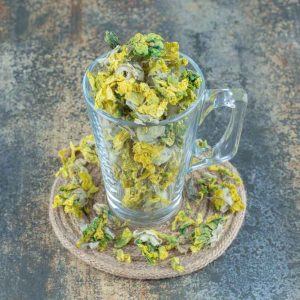Kratom (Mitragyna speciosa) is a tropical tree native to Southeast Asia, known for its leaves that contain psychoactive compounds. The primary active components in kratom are alkaloids, which play a significant role in its effects. Understanding these alkaloids is crucial for both users and researchers, as they can influence everything from pain relief to potential risks like addiction. In this article, we’ll delve into what alkaloids are, specifically those found in kratom, and why they matter.
Understanding Alkaloids
Alkaloids are naturally occurring compounds that contain nitrogen atoms. They are found in various plants and are known for their wide range of pharmacological effects. Examples include caffeine in coffee, nicotine in tobacco, and morphine in opium poppies. Alkaloids often have significant physiological effects on humans and animals, making them important in both traditional and modern medicine.
Expert Insight: Dr. Christopher Hughes, MD – Addiction Medicine Specialist: “Mitragynine, the primary alkaloid in kratom, interacts with opioid receptors in the brain, potentially explaining its pain-relieving effects. However, this also raises concerns about dependence and addiction potential.”
[Look for Dr. Hughes’ research on the pharmacology of kratom alkaloids.]
Key Alkaloids in Kratom
1. Mitragynine
Mitragynine is the most abundant alkaloid in kratom leaves, comprising up to 66% of the total alkaloid content. It is primarily responsible for kratom’s analgesic (pain-relieving) and stimulant effects. Mitragynine interacts with opioid receptors in the brain, which helps explain its effectiveness in pain management.
2. 7-Hydroxymitragynine
Though present in much smaller quantities (less than 2%), 7-hydroxy mitragynine is considerably more potent than mitragynine. It has strong analgesic properties and contributes significantly to kratom’s effects. This alkaloid is also believed to play a role in kratom’s potential for dependence and withdrawal symptoms.
Expert Insight: Dr. Joanne Ladner, Ph.D. – Pharmacologist & Kratom Researcher: “The diverse range of alkaloids in kratom contributes to its complex effects. While mitragynine is dominant, other alkaloids like 7-hydroxy mitragynine may influence the overall experience, including potential side effects.”
[Look for Dr. Ladner’s publications on the interaction between different kratom alkaloids.]
3. Other Alkaloids
Kratom contains over 40 different alkaloids, each contributing to its overall effects. Some of these include:
- Paynantheine: The second most abundant alkaloid, known for its muscle relaxant properties.
- Speciogynine: Acts as a smooth muscle relaxer.
- Ajmalicine: Known for its potential anti-hypertensive effects.
These alkaloids, although present in smaller amounts, contribute to the synergistic effects of kratom.
The Importance of Alkaloids in Kratom
Therapeutic Benefits
Kratom alkaloids have shown potential in managing various conditions, from chronic pain to anxiety and opioid withdrawal. Mitragynine and 7-hydroxy mitragynine, in particular, are noted for their pain-relieving and mood-enhancing properties.
Expert Insight: American Kratom Association (AKA): “The AKA, a kratom advocacy group, emphasizes the need for more research on kratom alkaloids and their potential therapeutic applications. They highlight the importance of quality control to ensure consistent alkaloid content in kratom products.”
[Link to the American Kratom Association website – American Kratom Association]
Risks and Side Effects
Despite its potential benefits, kratom is not without risks. The interaction of its alkaloids with opioid receptors raises concerns about dependence and withdrawal symptoms, especially with prolonged use. Users may also experience side effects such as nausea, dizziness, and constipation.
Expert Insight: National Institute on Drug Abuse (NIDA): “NIDA acknowledges the limited research on kratom and its alkaloids. They advise caution regarding kratom use due to potential risks like addiction, withdrawal symptoms, and interactions with medications.”
[Link to the NIDA website on kratom – Kratom (.gov)]
Research and Regulation
Need for Further Research
The full scope of kratom’s effects, particularly those of its less-studied alkaloids, remains to be understood. Ongoing research is crucial to elucidate the mechanisms by which these compounds exert their effects and to determine their safety profiles.
Expert Insight: Dr. David Nutt, Ph.D. – Neuropsychopharmacologist: “Dr. Nutt, a prominent advocate for evidence-based drug policy, emphasizes the need for unbiased research on kratom and its alkaloids. He highlights the importance of weighing potential benefits against risks and advocating for responsible kratom use.”
[Search for interviews with Dr. David Nutt discussing kratom research needs.]
Regulatory Perspectives
Kratom’s legal status varies widely around the world. Some countries have banned its use, while others regulate it similarly to other herbal supplements. In the United States, the FDA has not approved kratom for any medical use, citing concerns about safety and potential for abuse.
Expert Insight: European Monitoring Centre for Drugs and Drug Addiction (EMCDDA): “The EMCDDA, a European drug monitoring agency, publishes reports on kratom, including information on its alkaloid profile and potential health risks. Their resources offer a global perspective on kratom use.”
[Link to the EMCDDA kratom drug profile – Kratom (Mitragyna speciosa) drug profile – EMCDDA]
Quality Control and Consumer Safety
Importance of Quality Control
Quality control is crucial in the kratom industry to ensure product safety and efficacy. Variations in alkaloid content can significantly impact the effects of kratom, making it important for consumers to choose products that are tested and certified by reputable labs.
Study Reference: Chemical Composition and Biological Effects of Kratom (Mitragyna speciosa): In Vitro Studies with Implications for Efficacy and Drug Interactions (National Institutes of Health): This study explores the chemical composition of kratom, focusing on various alkaloids and their potential biological effects. It highlights the need for further research on interactions between alkaloids and potential drug interactions.
[Link to the study – Chemical composition and biological effects of kratom (Mitragyna speciosa): In vitro studies with implications for efficacy and drug interactions]
Responsible Use
Given the potential for dependence and adverse effects, users need to approach kratom with caution. Starting with low doses, consulting healthcare professionals, and being aware of legal regulations can help mitigate risks.
Conclusion
Kratom’s alkaloids, particularly mitragynine and 7-hydroxy mitragynine, play a significant role in its therapeutic effects and potential risks. While there is promising evidence for its use in pain management, anxiety relief, and other conditions, the lack of comprehensive research and regulation calls for cautious and informed use.
For those considering kratom, understanding the importance of alkaloids and their effects is essential. Consulting healthcare professionals, choosing products from reputable sources, and staying informed about ongoing research can help maximize the benefits of kratom while minimizing its risks.





